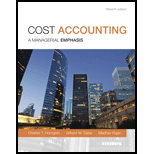
Cost Accounting (15th Edition)
15th Edition
ISBN: 9780133428704
Author: Charles T. Horngren, Srikant M. Datar, Madhav V. Rajan
Publisher: PEARSON
expand_more
expand_more
format_list_bulleted
Textbook Question
Chapter 9, Problem 9.24E
Capacity management, denominator-level capacity concepts. Match each of the following numbered descriptions with one or more of the denominator-level capacity concepts by putting the appropriate letter(s) by each item:
- a. Theoretical capacity
- b. Practical capacity
- c. Normal capacity utilization
- d. Master-budget capacity utilization
- 1. Measures the denominator level in terms of what a plant can supply
- 2. Is based on producing at full efficiency all the time
- 3. Represents the expected level of capacity utilization for the next budget period
- 4. Measures the denominator level in terms of demand for the output of the plant
- 5. Takes into account seasonal, cyclical, and trend factors
- 6. Should be used for performance evaluation in the current year
- 7. Represents an ideal benchmark
- 8. Highlights the cost of capacity acquired but not used
- 9. Should be used for long-term pricing purposes
- 10. Hides the cost of capacity acquired but not used
- 11. If used as the denominator-level concept, would avoid the restatement of unit costs when expected demand levels change
Expert Solution & Answer
Trending nowThis is a popular solution!

Students have asked these similar questions
Accounting problem
Can you explain the correct methodology to solve this general accounting problem?
None
Chapter 9 Solutions
Cost Accounting (15th Edition)
Ch. 9 - Differences in operating income between variable...Ch. 9 - Why is the term direct costing a misnomer?Ch. 9 - Do companies in either the service sector or the...Ch. 9 - Explain the main conceptual issue under variable...Ch. 9 - Companies that make no variable-cost/fixed-cost...Ch. 9 - The main trouble with variable costing is that it...Ch. 9 - Give an example of how, under absorption costing,...Ch. 9 - What are the factors that affect the breakeven...Ch. 9 - Critics of absorption costing have increasingly...Ch. 9 - What are two ways of reducing the negative aspects...
Ch. 9 - Prob. 9.11QCh. 9 - Describe the downward demand spiral and its...Ch. 9 - Will the financial statements of a company always...Ch. 9 - Prob. 9.14QCh. 9 - The difference between practical capacity and...Ch. 9 - Prob. 9.16ECh. 9 - Prob. 9.17ECh. 9 - Prob. 9.18ECh. 9 - Prob. 9.19ECh. 9 - Prob. 9.20ECh. 9 - Prob. 9.21ECh. 9 - Prob. 9.22ECh. 9 - Prob. 9.23ECh. 9 - Capacity management, denominator-level capacity...Ch. 9 - Prob. 9.25ECh. 9 - Prob. 9.26ECh. 9 - Prob. 9.27ECh. 9 - Prob. 9.28PCh. 9 - Prob. 9.29PCh. 9 - Prob. 9.30PCh. 9 - Prob. 9.31PCh. 9 - Motivational considerations in denominator-level...Ch. 9 - Prob. 9.33PCh. 9 - Prob. 9.34PCh. 9 - Prob. 9.35PCh. 9 - Prob. 9.36PCh. 9 - Prob. 9.37PCh. 9 - Prob. 9.38PCh. 9 - Prob. 9.39PCh. 9 - Prob. 9.40PCh. 9 - Prob. 9.41PCh. 9 - Prob. 9.42P
Knowledge Booster
Learn more about
Need a deep-dive on the concept behind this application? Look no further. Learn more about this topic, accounting and related others by exploring similar questions and additional content below.Similar questions
- 1 1. Provide BOTH the Direct and Indirect cash flow from operations 2. 3. 4. 5. 6. 7. There is no Foreign Exchange Effect. You do not need to provide a line item for that. I will NOT provide Balance Sheet information. This means you will NOT be able to prove out the Net Change in Cash nor the Closing Balance for the sum of Cash, Cash Equivalents and Restricted Cash. There is no Restricted Cash. So if you prefer to show the Opening and Closing balances as the sum of Cash and Cash Equivalents and not refer to Restricted Cash that is fine and even preferred. Be sure to provide a section for Disclosures. Those disclosures must refer to the Indirect Method you are asked to prepare in item #1 above. BE SURE TO PUT YOUR NAME ON YOUR EXCEL SPREADSHEET SO I KNOW WHO TO AWARD THE GRADE TO. GOOD LUCK! The company began the year with a credit balance in Trade Accounts Payable to inventory vendors of $ 300,000. During the year, vendors were paid $ 500,000. The vendors delivered $ 800,000 in…arrow_forwardCan you explain this general accounting question using accurate calculation methods?arrow_forwardI need guidance with this general accounting problem using the right accounting principles.arrow_forward
- I am searching for the accurate solution to this general accounting problem with the right approach.arrow_forwardI am trying to find the accurate solution to this general accounting problem with the correct explanation.arrow_forwardPlease help me solve this general accounting problem with the correct financial process.arrow_forward
arrow_back_ios
SEE MORE QUESTIONS
arrow_forward_ios
Recommended textbooks for you
 Cornerstones of Cost Management (Cornerstones Ser...AccountingISBN:9781305970663Author:Don R. Hansen, Maryanne M. MowenPublisher:Cengage Learning
Cornerstones of Cost Management (Cornerstones Ser...AccountingISBN:9781305970663Author:Don R. Hansen, Maryanne M. MowenPublisher:Cengage Learning Managerial Accounting: The Cornerstone of Busines...AccountingISBN:9781337115773Author:Maryanne M. Mowen, Don R. Hansen, Dan L. HeitgerPublisher:Cengage LearningPrinciples of Accounting Volume 2AccountingISBN:9781947172609Author:OpenStaxPublisher:OpenStax College
Managerial Accounting: The Cornerstone of Busines...AccountingISBN:9781337115773Author:Maryanne M. Mowen, Don R. Hansen, Dan L. HeitgerPublisher:Cengage LearningPrinciples of Accounting Volume 2AccountingISBN:9781947172609Author:OpenStaxPublisher:OpenStax College

Cornerstones of Cost Management (Cornerstones Ser...
Accounting
ISBN:9781305970663
Author:Don R. Hansen, Maryanne M. Mowen
Publisher:Cengage Learning

Managerial Accounting: The Cornerstone of Busines...
Accounting
ISBN:9781337115773
Author:Maryanne M. Mowen, Don R. Hansen, Dan L. Heitger
Publisher:Cengage Learning

Principles of Accounting Volume 2
Accounting
ISBN:9781947172609
Author:OpenStax
Publisher:OpenStax College
Why do we need accounting?; Author: EconClips;https://www.youtube.com/watch?v=weCXE2wIl90;License: Standard Youtube License